The Evil Queen behind the Disney Tales

Fredegund Queen of Neustria
RNfinity | 04-02-2023Key Questions
Who was Fredegund and what was her role in the Merovingian Kingdom?
Fredegund began as an enslaved servant who rose to power by becoming the Queen Consort of King Chilperic I and later ruled as regent from 584 to 597. She was known for her cunning political strategies, ruthless leadership, and influence over a vast area that included modern-day France and parts of Germany and Switzerland.
What tactics did Fredegund use to gain and maintain her power?
Fredegund used manipulation, assassinations, and alliances to consolidate power. She was known for assassinating rivals, outmaneuvering political threats, and using espionage and deception, including disguising troops to gain tactical advantages in battle.
How did Fredegund’s rivalry with Brunhilda shape her rule?
Fredegund’s rivalry with Brunhilda was marked by constant conflict, assassinations, and battles. This intense feud not only influenced the political landscape of the Merovingian Kingdom but also became legendary for its brutality, with Fredegund and Brunhilda continuously vying for dominance.
What role did Salic Law play in the Merovingian Kingdom’s succession issues?
Salic Law dictated patrilineal succession, excluding women from inheritance. However, all male heirs could claim a share, leading to fragmented rule and internal conflicts, as sons of the same household later became fierce rivals for power and territory.
How did Fredegund use her children and marriage alliances to strengthen her rule?
Fredegund leveraged her children in alliances, including securing protection by offering her son as heir to the widowed King Gunthar. Her daughter Rigunth was used as a marriage pawn in a planned alliance with the Visigoths, highlighting her strategic use of family ties.
What lasting impact did Fredegund leave on history?
Fredegund’s brutal tactics, reputation for manipulation, and innovations in espionage left a legacy of female power feared in male-dominated societies. She influenced laws to restrict female regency and inspired legends of the “evil queen” in historical narratives and folklore.
How is Fredegund’s legacy portrayed in historical accounts?
Fredegund is often portrayed as a villain in historical accounts, especially in Gregory of Tours' writings, where she is depicted as ruthless and scheming. Her influence on subsequent narratives about female power reflects societal fears and biases against strong female rulers.
Fredegund grew up in the 6th Century. She was an uneducated, enslaved Royal Servant, likely of pagan origin, who eventually seduced the married Frankish King Chilperic I and persuaded him to depose of two of his wives in favour of her, but eventually she took his power as a Regent from 584 to 597, after his death, overseeing his son to become one of the most cunning leaders the world has ever seen. Together with her equally formidable sister-in-law, Brunhilda, who she despised and repeatedly tried to assassinate, they ruled over a whole swathe of land running from France to West and Southern Germany, Luxembourg, Switzerland, and Austria. Western Europe would not see such a rivalry between Queens until, that which arose, between Queen Elizabeth 1st and Mary Queen of Scots, one thousand years later. She has often been derided for her bloody acts and disregard for societal boundaries, and religious sanctity that would make Machiavelli blush. But she was also a little-known innovator of the dark arts of espionage, politics, and assassination. She was a political and military genius who flourished in a brutal era, where there was no such role for women. She created a fearful symbol of female power that male-dominated societies did not hope to see again. Throughout her life, she was accused of witchcraft, murder, and adultery, but it was only the latter of these that she vehemently denied.
The Merovingian Kingdoms source: Merovingian dynasty - Merovingian dynasty - Wikipedia
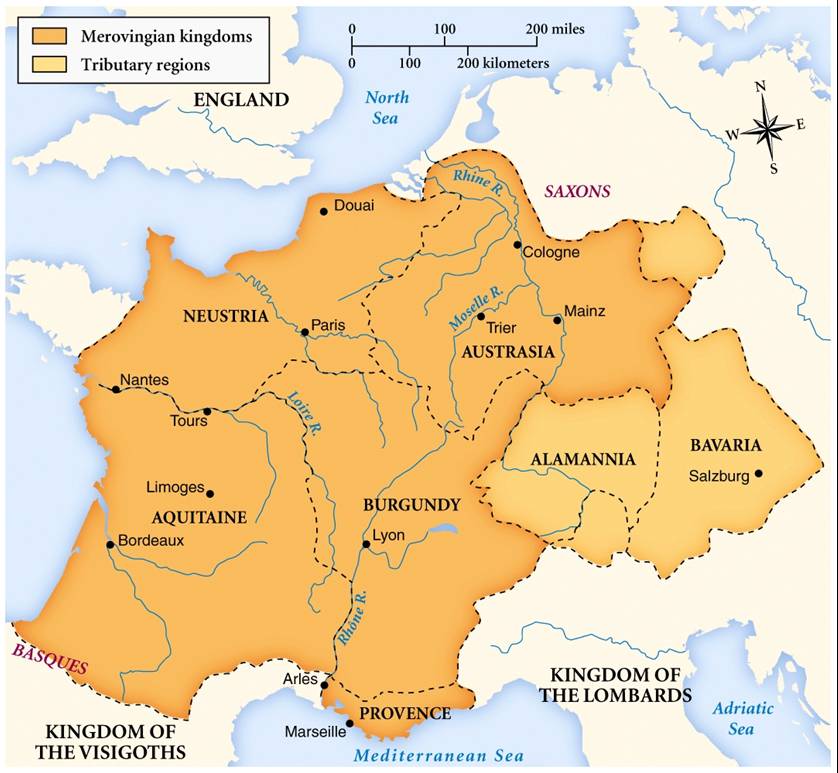
In the Sixth Century, in the Merovingian Kingdom, Salic Law was practiced, which governed the laws of succession. Patrilineal succession (excluding female heirs) was practiced; however, primogeniture (the firstborn takes all) was not practiced, meaning that all male offspring could exercise a claim to inheritance. This led to centuries of discord where childhood siblings under one household would later become mortal enemies on the battlefield. Clothar I died in 561, leaving the land of the Frankish Kingdoms divided between his four sons: Chilperic I (the smallest kingdom of Soissons or Neustria), Guntram (kingdom of Orleans), Sigebert (kingdom of Rheims), and Charibert I (kingdom of Paris). It is in this context that Fredegund enters the fray.
Enchanting the King
Fredegund was sold to King Chilperic I. She worked in the royal household, where she most likely served Chilperic’s wife Audovera. At this time, Audovera had given birth to five children. Fredegund seduced Chilperic to become his concubine, but she had grander ideas and plotted to have Audovera removed. It is told that Fredegund, who was aware of the finer print of the law, tricked Audovera into handling her own child Childesinda immediately after baptism, which was at that time a taboo. When Chilperic learned of this from Fredegund, he divorced Audovera and sent her to a convent. Audovera later plotted against Fredegund, and one of Audovera's sons, Merovich, subsequently married Fredegund's adversary, the later-to-be-widowed Brunhilda. However, things didn’t go according to Fredegund’s plan, from the outset at least. Chilperic’s brother Siegfried had taken Brunhilda, a royal princess from the Spanish empire, as his wife, forming a powerful alliance. So instead of Fredegund, Chilperic took Brunhilda’s sister Galswintha as his bride, seeking too a political alliance with Spain. Gregory of Tour wrote that 'Chilperic loved Galswintha dearly at the outset for she came with much dowry', but the union was short-lived. Galswintha was found strangled, most likely at the orders of Fredegund or Chilperic under the direction of Fredegund. After a three-day period of mourning, Fredegund became Chilperic’s wife and she became the Regent Queen; a position she would never relinquish until her death. By all accounts, Chilperic was spellbound by Fredegund and he did whatever he could to please her. Brunhilda was enraged with Fredegund for the death of her sister, as it was common knowledge that the murder was perpetrated at the behest of Fredegund, and these two Queens of neighboring kingdoms would become lifelong adversaries.
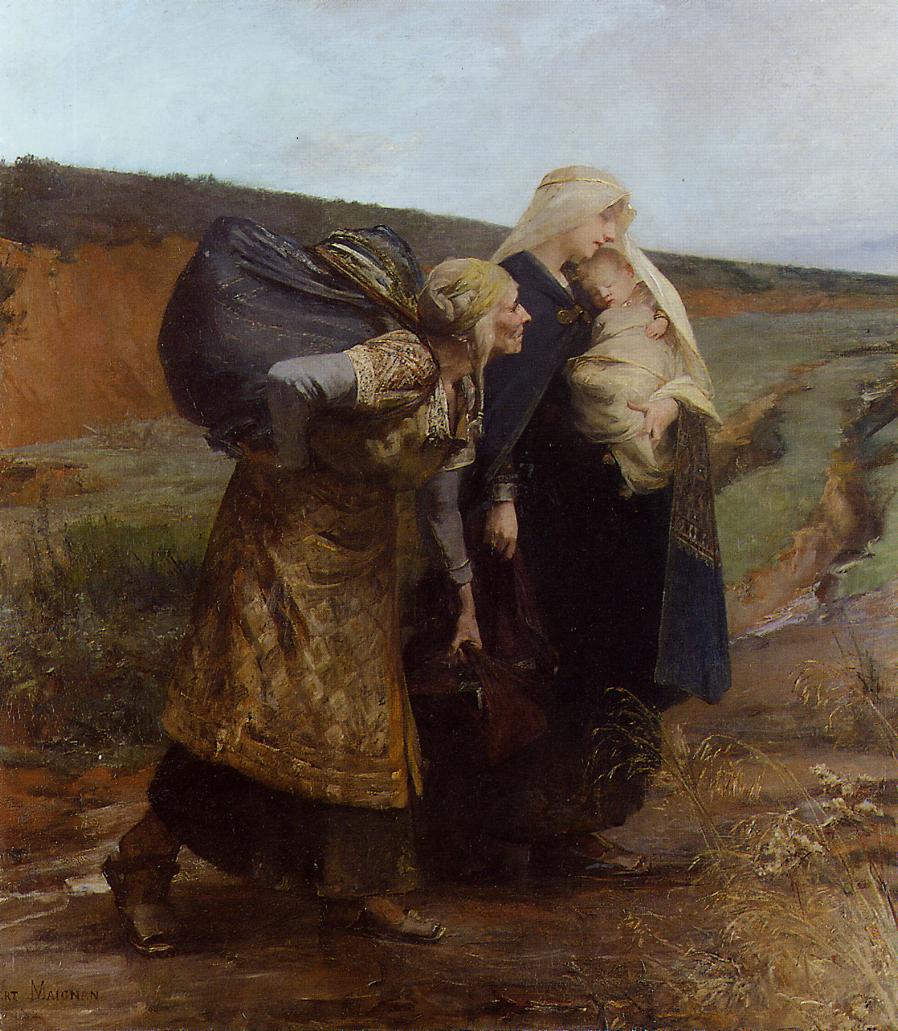
Audovera repudiated by Albert Maignan (public domain)
The Politics of Pregnancy
In Frankish monarchy, women had no power per se, and Fredegund ruled by acting as a consort to her young male heir Clothar. After her husband Chilperic I was murdered, her grasp of power was always fragile, and she could only remain in power whilst she had a living male heir. In those days, infant mortality from disease was very high. She was actually pregnant when her husband died, but she had kept this pregnancy a secret. The other rulers of the Frankish kingdom, sensing her vulnerability after Chilperic had died, sought to seize her lands. However, after she gave birth to a boy, she used this as a ploy to obtain an alliance with King Gunthar, who was widowed without an heir and sworn to celibacy, and she offered for her son to become the heir to his kingdom in exchange for her protection from the other Frankish kingdoms. Gunthar protected Fredegund and stayed in her palace in Rouen; however, this was very much an arrangement of convenience, and she sought to detach herself from his orbit. To accomplish this, she stated she was pregnant; however, it was most likely that she feigned pregnancy for her own benefit. It is not known who killed her husband Chilperic. There are rumors that this may have been at the hands of Fredegund, but this seems less likely, as it would have greatly weakened her grasp on power, and she would have only contemplated this if he sought to divorce her or execute her, perhaps on the grounds of adultery.
False Flags, Fake Forests, and Golden Breastplates
The battle to defend Soissons against a much larger force of Brunhilda took place in the fields of Droizy, and her tactics were famously depicted in Shakespeare’s Macbeth, where soldiers from an enemy army cut down the trees of Great Birnam Wood and used them as camouflage to get closer to Macbeth's castle at Dunsinane. This is exactly what transpired; she ordered her soldiers to stealthily approach the enemy soldiers in the night by disguising themselves as trees. The soldiers also carried bells to mimic domestic horses grazing. This trickery led to a decisive victory against a much larger army. This story is part of Celtic legend; it is not clear if she copied the strategy from legend or if she invented this strategy and thereby created this legend. In another battle, where she sought to assist and ally without being discovered, she asked her troops to disguise themselves as Bretons by cutting their long locks of hair and wearing their livery. The ruse worked. The battle was won, and her assistance was undiscovered. She gained the trust of her military commander, who recognized her tactical genius, and she led her troops out to battle riding on horseback wearing a golden breastplate to mimic her arch-nemesis Brunhilda.
Assassinations by Axe and Poisonings
Fredegund was responsible for many murders and attempted assassinations. She attempted to assassinate her arch-foe Brunhilda on many occasions, but all of these attempts were foiled. Fredegund was alleged to have been an innovator of poison techniques. She designed knives with grooves cut in them where poison could be stored, and she is believed to have developed methods of permitting poisons such as snake venom and wolfsbane to be shelf-stable for storage. She would typically rely on servants and promise them or their families rewards. She would tell them that she would give them a potion that would make them very brave, most likely alcohol. These missions were pretty much suicide missions, with the chance of survival for the perpetrator being remote.

Fredegund infamously settled a dispute between two feuding families by inviting the surviving members to sit together at a lavish banquet with many guests. As the night wore on and the guests became increasingly intoxicated with absinthe, three axemen entered the room to decapitate the three feuding members of the family in front of the startled guests. Sigebert and Brunhilda waged war on Soissons in retaliation for the murder of her sister Galswintha at the hands of Fredegund and Chilperic, and their larger army had penetrated deep into the territory of Soissons. By 575, the fighting had reached the capital city of Soissons. Sigebert and Brunhild took up residence in Paris, with plans to adopt it as their new capital. Chilperic fled Soissons before the surrounding army could prevent his escape. Sigebert rode out triumphantly to accept an offer of loyalty from the nobles in Chilperic’s northernmost territories. Brunhilda too was being celebrated as Queen of Paris. Meanwhile, Fredegund was in a secret hiding place many miles away. Fredegund summoned two slave boys and persuaded them to slip into the gathering where the armies were celebrating Sigebert’s victory and assassinate Sigebert. It was common during the time for all men to carry a small hunting knife, and the boys could get away with carrying them openly on their belts without raising suspicion. Fredegund handed the boys a small glass vial of poison to smear the blades just before the assassination. The would-be assassins entered the camp by declaring themselves Neustrian defectors. They smeared their blades with the poison and hung the knives back on their belts, and caught up with the king, pretending they wanted to have an audience with him. One of the boys managed to surprise the king and his guards. Only a slight nick with the blade was required. The King's guard quickly killed the two boys, but within a few moments, Sigebert swiftly succumbed to the poison and died. Sigebert’s assassination decisively changed the battle. Sigebert’s armies fled in disarray. Chilperic and Fredegund came out of hiding and were able to control Paris and expanded their territory. Fredegund had won the respect of her husband and she became his most trusted political adviser. Audovera, Chilperic’s first wife, was later murdered by Fredegund in 580, Fredegund exacting her final revenge.
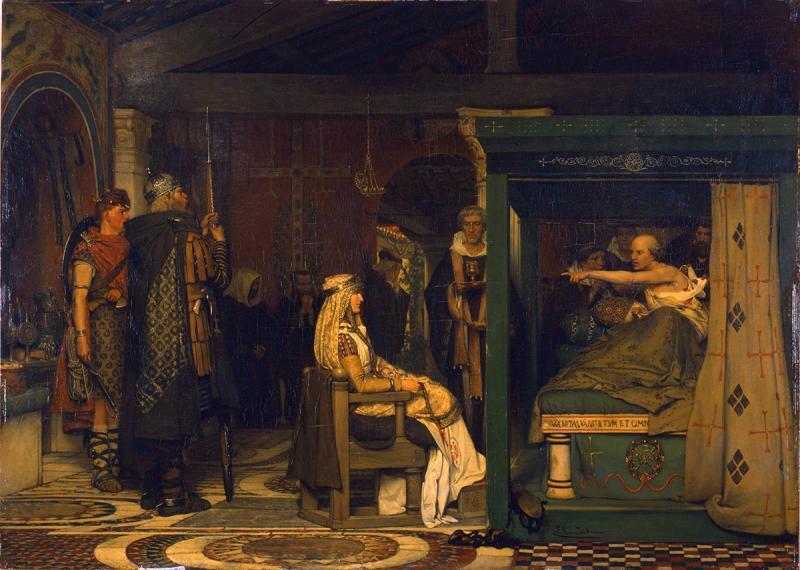
By Lawrence Alma-Tadema - http://www.arts-museum.ru, Public Domain
Sadly, Fredegund killed and tortured many others from those who spurned her advances, those who dared to defy her, or servants who had failed at their tasks.
Trouble with the Kids
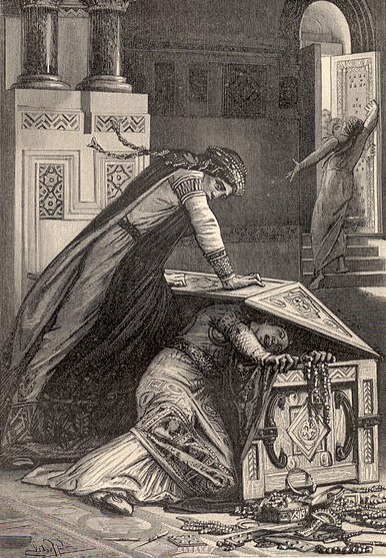
Fredegund's relationship with her children, particularly if they were stepchildren or of the female gender, was troubled to say the least. She attempted to marry off her daughter Rigunth to the Spanish Visigoth fiancé Reccared, sending her off in a carriage with a very large dowry. However, the royal carriage was repeatedly ransacked on the journey, and eventually, the guards fled. During this journey, King Chilperic died, leaving her in no man’s land. Eventually, she returned to Fredegund’s residence. They would often have fights, punching and slapping each other. She boasted that she would outshine her mother and that she was more desirable. Fredegund grew jealous of her youth. One day, feigning an act of appeasement, she ushered her daughter into the royal treasure room and beckoned her to delve into a Royal chest and pick whatever item she fancied. Whilst peering into the chest, Fredegund attempted to kill her daughter by slamming the chest door against her neck, and she was only saved through the intervention of the astonished Royal Staff. They parted company. It is not known what became of her, whether she was sent away to a monastery, or how long she lived.
Fredegund bore Chilperic a son called Samson. She seemed to be suffering from postpartum depression and wanted Samson killed before he was baptized because she thought he might become an asset for Brunhilda. Chilperic was furious and had his son baptized. Samson, however, later died at the age of 5 from natural causes. Fredegund’s other sons, Clodobert and Dagobert, died of dysentery. Fredegund created a rumor that they were killed using witchcraft and that the culprit was her stepson Clovis from Chilperic’s marriage to Audovera. He was captured and died under mysterious circumstances, where he allegedly stabbed himself.
Burning It Off
Fredegund and Chilperic’s two-year-old son, Theuderic, died of dysentery in the year 584. It was a natural death due to disease. Fredegund and Chilperic, in despair, thought that foul play was afoot. The couple believed that witches and sorcerers in Paris were responsible for the death of their son. Suspicion was especially focused on healers who had come to Paris to treat those suffering from disease. Bishop and historian Gregory of Tours (c. 539-594) wrote of the witch hunts that occurred because of these conspiracy theories: “Fredegund then had these poor wretches tortured in an even more inhumane way, cutting off the heads of some, burning others alive, and breaking the bones of the rest on the wheel.” Mummolus, a man accused by the royals of being a sorcerer, according to Gregory, was tortured on the rack and flogged. The tortured man never fully recovered from his wounds and ultimately succumbed to them. Fredegund destroyed any artifacts she could find that reminded her of her deceased.
Her Legacy

Fredegund died of natural causes in 597. At least there were no rumors that she was assassinated. Her son Clothar managed to achieve what she long strove for. His forces eventually defeated the forces of Brunhilda. The then 70-year-old monarch and her children were finally captured. Clothar executed her and two of her sons, sparing the youngest, who he was godfather to. Brunhilda was executed in the most brutal fashion. Her body was torn asunder, having been tied to several horses which were spurred to charge in opposite directions. Eventually, the Frankish kingdoms were all united under the rule of Clothar. So it was Fredegund who provided the bloodline for the Royal progression, not Brunhilda. Clothar, after avenging his mother, sought to erase all her deeds, both the triumphs and the atrocities, from the historical records. Her gravestone, which depicts a body without a face, only states that she was the wife of Chilperic. However, we know much about her life from a detailed contemporary account provided by Gregory of Tours, a bishop who was employed by Brunhilda, though he perhaps gives a biased account depicting Fredegund as the villain of every encounter. After the rule of Brunhilda and Fredegund, the laws were changed to prevent female regents from maintaining any power, and so the fairy tales of female rulers began: the evil narcissistic Queen or the wicked stepmother who controls her children, bewitching feeble men to do their bidding. Do these all originate from Fredegund? It is not clear; perhaps there was another regent utterly lost to history, but perhaps it was Fredegund after all, maybe just maybe.
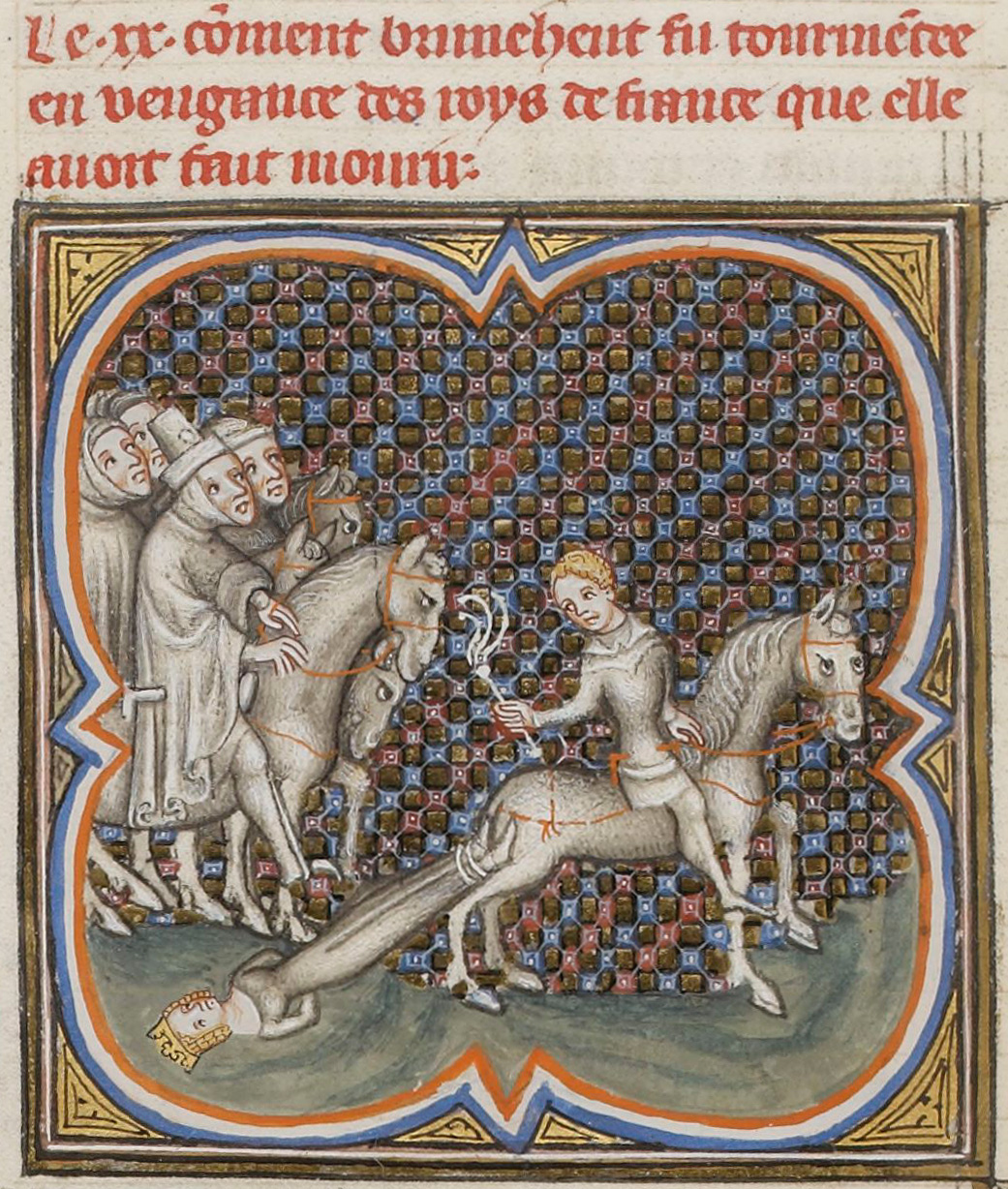
The execution of Brunhilda from circa 1375
Find Out More
- The Dark Queens by Shelley Puhak. Copyright © 2022. Used by permission of Bloomsbury.
- Super Special: Fredegund, Queen of Neustria: Part One • Vulgar History by Ann Foster on Spotify.
- Super Special: Fredegund, Queen of Neustria: Part Two - Vulgar History by Ann Foster on Spotify.
- Super Special: Fredegund, Queen of Neustria: Part Three - Vulgar History by Ann Foster on Spotify.